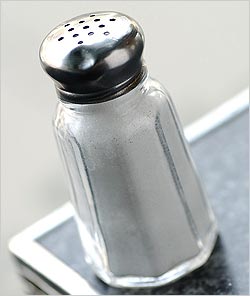food
Public Health Group: FDA Should Regulate Sodium
- by Karlene Lukovitz @KLmarketdaily, November 1, 2011
 The American Public Health Association (APHA) has passed a resolution calling on the Food and Drug Administration to start regulating sodium levels in
processed and restaurant foods, and set a schedule to progressively reduce those levels by 75% within 10 years.
The American Public Health Association (APHA) has passed a resolution calling on the Food and Drug Administration to start regulating sodium levels in
processed and restaurant foods, and set a schedule to progressively reduce those levels by 75% within 10 years.
The resolution, passed during APHA’s annual meeting this week in
Washington, D.C., urges the FDA to either remove or modify sodium’s GRAS (generally recognized as safe) status, which would trigger FDA regulation of sodium in foods. The Institute of Medicine
has also recommended that the FDA regulate sodium in food.
APHA also calls on the FDA to require the food industry to use 2,300 mg as the current standard for calculating sodium daily
values in processed foods, set sodium’s DV standard at 1,500 mg by 2017, and establish a front-of-package label that clearly identifies whether products are high, medium or low in sodium
content.
advertisement
advertisement
The American Heart Association has recommended a 1,500-mg daily sodium limit for all Americans, and the U.S. Dietary Guidelines Advisory Committee unanimously concurred. However, the 2010 Dietary Guidelines reflect recommendations by the U.S. Department of Agriculture and Department of Health and Human Services: a 1,500-mg daily maximum for those with hypertension, diabetes or kidney disease and those who are black or 51 or older (which together cover about 70% of the adult population), and a 2,300-mg daily maximum for the rest of the population.
APHA says that even young adults are now developing hypertension (one 2011 study found that 19% of those 24 to 32 have the condition), and that extending the 1,500 standard to all would “substantially reduce the mean blood pressure of the U.S. population.”
APHA stressed that a 2010 Institute of Medicine report stated 40 that years of a voluntary approach to sodium reduction by the food industry had failed. “Rapid, effective” actions by the FDA and food industry are urgently needed and “long overdue,” the APHA resolution emphasizes: “Without a decrease of at least 75% in the sodium content of processed and restaurant foods, it will be exceedingly difficult, if not impossible, for most Americans to consume no more than 1,500 mg sodium daily.”
According to the APHA, many countries are far ahead of the U.S. in reducing sodium consumption and associated health problems. For example, Finland -- which started regulation and public education to reduce sodium in the 1970s -- has decreased intake by more than 40%, significantly reduced mean blood pressure, and cut the country’s heart disease and stroke mortality rate by 80%.


